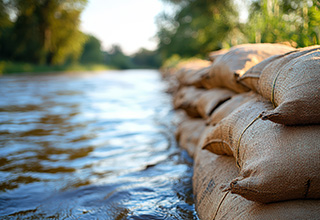NIH Program on Health and Extreme Weather

NIH is uniquely positioned to lead this solutions-focused research initiative to reduce the health consequences associated with extreme weather and emerging environmental harms. NIH has a strong history of creating innovative tools, technologies, and data-driven solutions to address global environmental problems.
The HEW Program works in close collaboration with the longstanding NIH Disaster Research Response (DR2) Program which provides tools and resources to facilitate and accelerate health research capacity to respond to disasters across the nation.
The NIH HEW Executive Committee
The NIH Program on Health and Extreme Weather (HEW) is led by an Executive Committee comprising the directors of several NIH institutes and centers. The NIEHS director co-chairs the Executive Committee with the director of the Fogarty International Center. NIEHS is the Program’s administrative home.
- Eunice Kennedy Shriver National Institute of Child Health and Human Development (NICHD)
- Fogarty International Center (FIC)
- National Cancer Institute (NCI)
- National Center for Complementary and Integrative Health (NCCIH)
- National Heart, Lung, and Blood Institute (NHLBI)
- National Institute of Allergy and Infectious Diseases (NIAID)
- National Institute of Arthritis and Musculoskeletal and Skin Diseases (NIAMS)
- National Institute of Environmental Health Sciences (NIEHS)
- National Institute of Mental Health (NIMH)
- National Institute of Nursing Research (NINR)
- National Institute on Aging (NIA)
- National Institute on Minority Health and Health Disparities (NIMHD)
Strategic Framework
The NIH Health and Extreme Weather (HEW) Strategic Framework (6MB) presents the mission, goals, and objectives of the NIH HEW Program, as well as high priority scientific approaches. A product of the NIH HEW Executive and Steering Committees, this framework includes input from NIH Institute and Center (IC) directors, program staff, and scientists.
The framework is intended to guide NIH’s short- and medium-term investments by providing concepts and examples of research that would generate scientific knowledge and innovations to address the most critical risks to human health across the lifespan that are associated with extreme weather.
NIH HEW Working Group
NIH established a working group for the HEW Program. Members meet regularly to identify evolving areas of science, discuss new research findings, and hear from internal and external partners. The working group represents a collaborative effort by Institutes and Centers across NIH to share knowledge and strengthen research capacity throughout NIH, and to increase understanding about the nature and behavior of living systems to enhance health, reduce illness and disability, and improve longevity and quality of life.
Community of Practice
The NIH HEW Program understands the critical need to create a global network of scientists, health practitioners, students, community members, and educators who are actively engaged with the latest research into the health effects of extreme weather and natural disasters.
Partnership With the National Science Foundation
The health challenges posed by extreme weather are multifaceted and complex, and they require a multidisciplinary research response. The NIH HEW Program is focused on building collaborations that foster comprehensive approaches to understanding and mitigating the health effects of extreme weather conditions.
NIH has established an agreement with the U.S. National Science Foundation to support two centers known for their disaster response expertise. This partnership enhances opportunities for exposure scientists to join the public health research community.
University of Colorado Boulder Natural Hazards Center
Principal Investigator: Lori Peek, Ph.D.
The University of Colorado Boulder Natural Hazards Center provides funding for timely collection of perishable data for health research in response to natural disasters. These rapid awards facilitate the ability of grantees to get into the field quickly after a disaster and work with affected communities on health-related studies. Learn more about the Natural Hazards Center.
Read research briefs from studies funded between 2023 and 2025.
University of Washington Natural Hazards Reconnaissance (RAPID) Facility
Principal Investigator: Joseph Wartman, Ph.D.
The University of Washington Natural Hazards Reconnaissance (RAPID) Facility offers an extensive inventory of technical instrumentation, training, and resources to researchers collecting perishable exposure and health data in post-disaster settings. New field sampling instruments and technologies are available to capture critical data on environmental exposures, including chemical contaminants, airborne pollutants, and waterborne hazards. Learn more about the RAPID Facility.


